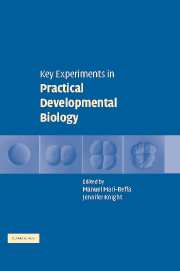Book contents
- Frontmatter
- Contents
- List of contributors
- Preface
- Introduction
- SECTION I GRAFTINGS
- SECTION II SPECIFIC CHEMICAL REAGENTS
- SECTION III BEAD IMPLANTATION
- SECTION IV NUCLEIC ACID INJECTIONS
- 9 RNAi techniques applied to freshwater planarians (Platyhelminthes) during regeneration
- 10 Microinjection of Xenopus embryos
- SECTION V GENETIC ANALYSIS
- SECTION VI CLONAL ANALYSIS
- SECTION VII IN SITU HYBRIDIZATION
- SECTION VIII TRANSGENIC ORGANISMS
- SECTION IX VERTEBRATE CLONING
- SECTION X CELL CULTURE
- SECTION XI EVO–DEVO STUDIES
- SECTION XII COMPUTATIONAL MODELLING
- Appendix 1 Abbreviations
- Appendix 2 Suppliers
- Index
- Plate Section
- References
10 - Microinjection of Xenopus embryos
Published online by Cambridge University Press: 11 August 2009
- Frontmatter
- Contents
- List of contributors
- Preface
- Introduction
- SECTION I GRAFTINGS
- SECTION II SPECIFIC CHEMICAL REAGENTS
- SECTION III BEAD IMPLANTATION
- SECTION IV NUCLEIC ACID INJECTIONS
- 9 RNAi techniques applied to freshwater planarians (Platyhelminthes) during regeneration
- 10 Microinjection of Xenopus embryos
- SECTION V GENETIC ANALYSIS
- SECTION VI CLONAL ANALYSIS
- SECTION VII IN SITU HYBRIDIZATION
- SECTION VIII TRANSGENIC ORGANISMS
- SECTION IX VERTEBRATE CLONING
- SECTION X CELL CULTURE
- SECTION XI EVO–DEVO STUDIES
- SECTION XII COMPUTATIONAL MODELLING
- Appendix 1 Abbreviations
- Appendix 2 Suppliers
- Index
- Plate Section
- References
Summary
INTRODUCTION
Microinjection of Xenopus embryos is an important technique with multiple applications in the fields of Cell Biology and Developmental Biology. Literally thousands of publications have resulted from use of these microinjection approaches. Fortunately, the equipment required for microinjection is inexpensive and compact and, due to the extremely large size of the Xenopus eggs and embryos, little practice is needed before the researcher becomes proficient with the technique. The purpose of this article is to provide a straightforward guide to microinjection methods. We will emphasize the most important factors when considering the equipment and materials required and we will describe procedures known to be reliable and efficient.
EQUIPMENT AND MATERIALS
INJECTION EQUIPMENT
Microscope. The technical specifications of a stereomicroscope suitable for microinjection are rather simple because the Xenopus embryos are large (about 1.2 mm across) and easily viewed under low magnification. The first concern is that the microscope has sufficiently good optics to be used for several hours (the length of a typical injection session) without causing eye strain. Second, the microscope must have a large working distance between the objective and the bench (at least 8–10 cm) to allow room for the microinjection apparatus, the injection dish and the operator's hands. To maximize the working distance the stereomicroscope should be supported by a boom stand rather than a conventional raised base (Figure 10.1a). Use of a boom stand provides a large working distance and also facilitates movement of the injection apparatus and dishes of embryos.
- Type
- Chapter
- Information
- Key Experiments in Practical Developmental Biology , pp. 117 - 126Publisher: Cambridge University PressPrint publication year: 2005



